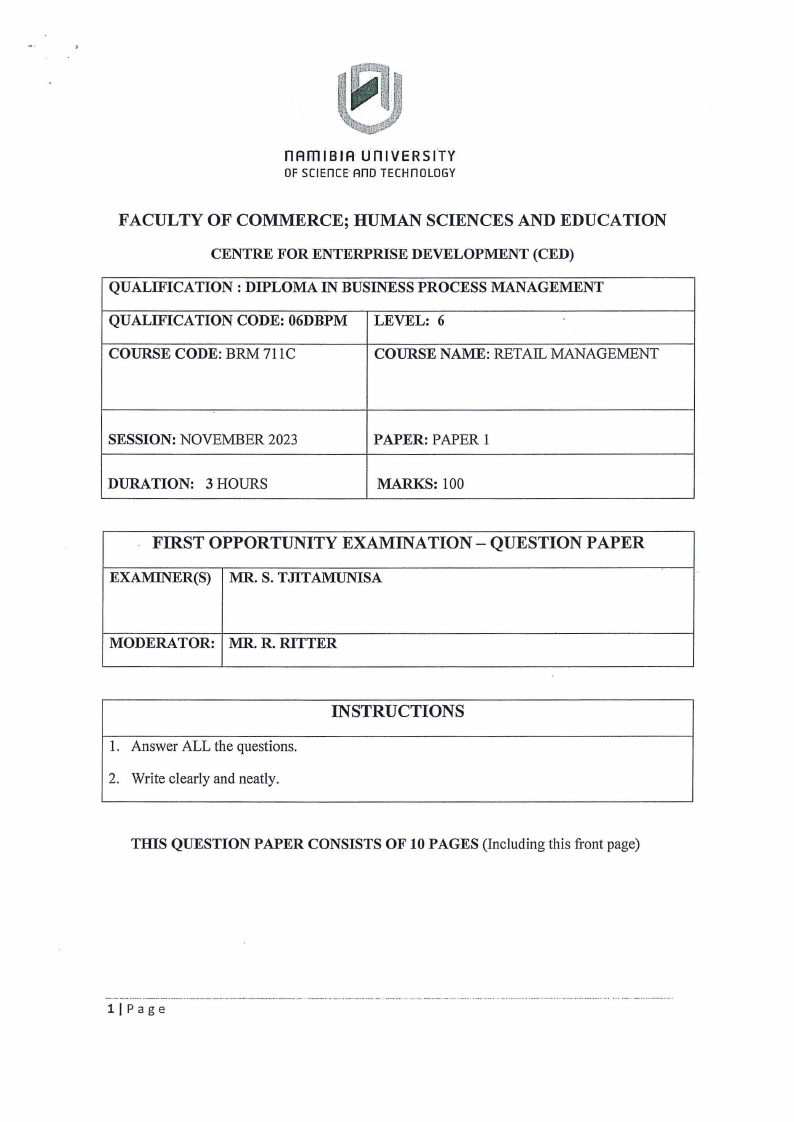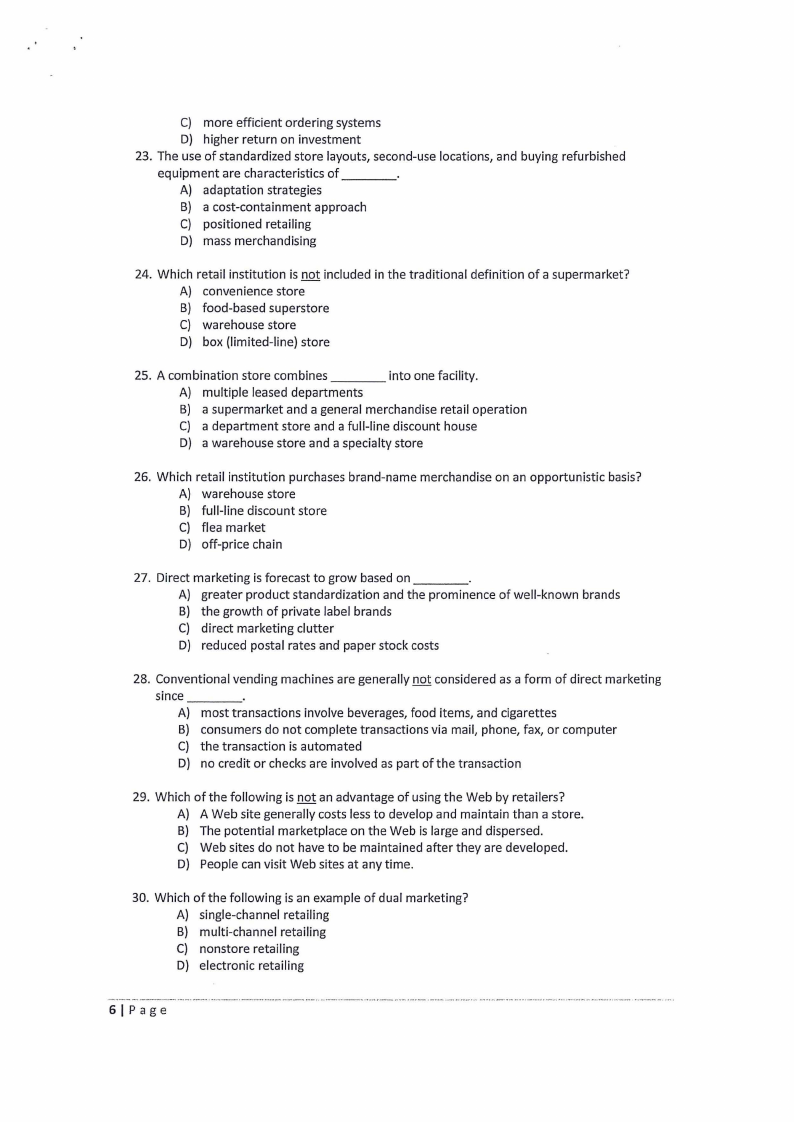 |
BAC621C-BUSINESS ACCOUNTING- 2ND OPP JULY 2024 |
 |
1 Page 1 |
▲back to top |

nAmlBIA
Un IVERSITY
OF SCIEnCEAno
TECHnOLOGY
HP-GSB~
HAROLDPUPKEWITZ
GraduateSchoolof Business
FACULTY OF COMMERCE, HUMAN SCIENCESAND EDUCATION
HAROLD PUPKEWITZGRADUATESCHOOLOF BUSINESS
QUALIFICATION: DIPLOMA IN BUSINESSPROCESSMANAGEMENT
QUALIFICATION CODE: 06DBPM LEVEL: 6
COURSECODE: BAC621C
COURSENAME: BUSINESSACCOUNTING2B
SESSION:JULY2024
PAPER:PAPER2
DURATION: 3 HOURS
MARKS: 100
SECOND OPPORTUNITY EXAMINATION QUESTION PAPER
EXAMINER
Gerhardt Sheehama
MODERATOR Lameck Odada
INSTRUCTIONS
1. This question paper is made up of four (4) questions.
2. Answer ALLthe questions in blue or black ink only. NO pencil
3. Start each question on a new page in your answer booklet and show all workings.
4. Round off only final answers to two (2) decimal places unless otherwise stated.
5. Questions relating to this examination may be raised in the initial 30 minutes after the
start of the paper. Thereafter, candidates must use their initiative to deal with any
perceived error or ambiguities & any assumption made by the candidate should be
clearly stated.
PERMISSIBLEMATERIALS
Silent, non-programmable calculators
THIS QUESTION PAPERCONSISTSOF 7 PAGES(including this front page)
 |
2 Page 2 |
▲back to top |

QUESTION 1
[20 MARKS]
Each of the following questions has only ONE correct answer. In your answer script, write down the numbers
1.1 to 1.10. Then, next to each number only write down the letter which, in your opinion, represents the
correct answer.
1.1 If the actual number of kilograms of direct material used exceeds the standard number
of kilograms allowed but actual price was less than standard price, the materials quantity
variance will be:
A Adverse
B Favourable
C Favour
D Adversa
1.2 If the actual number of kilograms of direct material used exceeds the standard number
of kilograms allowed but actual price was less than standard price, the materials price
variance will be:
A Adverse
B Favourable
C Favour
D Adversa
1.3 The following method of evaluating capital projects does NOTtake into account the time
value of money:
A Payback period
B Discounted payback period
C Net present value
D Internal rate of return
1.4 The following method of evaluating capital projects does NOTtake into account cash flows
over the entire life of the project:
A Payback period
B Accounting rate of return
C Net present value
D Internal rate of return
1.5
A
B
C
D
The following statement is NOT true:
If the net present value of a project is negative, the project is not profitable.
The discounted payback method does not take into consideration all cash flows.
The net present value can be positive or negative.
When funds for capital projects are limited, the most profitable investment will be the
one with the shortest payback period.
1.6 The following factor does NOT affect cash flow:
A Funds from the issue of share capital
B Revaluation of a fixed asset
C Decrease in the level of trade debtors
D Repayment of a bank loan
2
 |
3 Page 3 |
▲back to top |

1.7 Nawa CCproduces and sells only one product. The following budgeted data is available:
Inventory levels (2022)
1 May
Raw material (kilograms)
1 000
Finished products (units)
500
Sales sold 1 800 units at N$150 per unit
Production units 1 900
31 May
600
???
The units of closing inventory (finished goods) is...
A 500
B 800
C 900
D 600
1.8 Wana CCproduces and sells only one product. The following budgeted data is available:
Inventory levels (2022)
Raw material (kilograms)
Finished products (units)
Selling price is N$30 per unit
Production units 3 800
lJune
2000
1000
31June
1000
1200
Budgeted sales in value (N$) is.....
A N$114 000
B N$108 000
C N$180 000
D N$124 000
The following information relates to questions 1.9 and 1.10:
A company uses standard costing and the standard variable overhead cost for a product is 6 direct labour hours
at N$10 per hour.
Last month when 3 900 units of the product were manufactured, the actual variable overheads was N$235 000
and 24 000 hours were worked.
1.9 The variable overhead expenditure variance for last month was:
A N$5 000 Adverse
B N$5 000 Favourable
C N$6 000 Adverse
D N$6 000 Favourable
1.10 The variable overhead efficiency variance for last month was:
A N$5 000 Adverse
B N$5 000 Favourable
C N$6 000 Adverse
D N$6 000 Favourable
3
 |
4 Page 4 |
▲back to top |

QUESTION 2
[24 MARKS]
Nancy Ltd supplied the following flexible budget for its Welding Department at output levels of 10 000 and 11
000 units respectively:
Activity level (units)
10 000
11000
Direct labour
Direct material
Indirect labour
Maintenance
Depreciation
50000
40000
80 000
18 000
16 000
204 000
55 000
44000
82 000
19 000
16 000
216 000
During the past month only 9 000 units were manufactured and the following costs were actually incurred:
Direct labour
Direct material
Indirect labour
Maintenance
Depreciation
48000
35 000
76 000
19 000
16100
194100
REQUIRED:
Prepare a Performance Report that will be useful to the management of Nancy Ltd.
Note: Round off variable cost per unit to two decimal places, total costs and variances to the nearest N$.
QUESTION3
[20 MARKS]
Leader Ltd manufactures a single product. The budget information for the following year was as follows:
Per unit
10 000 units
Sales at N$23.50 per unit
23.50
235 000
Production costs:
Direct material - 5 kg @ N$2 per kg
Direct labour-1 hour@ N$5 per hour
Variable overheads -1 labour hour
Standard marginal cost
Fixed cost
Standard profit
10.00
5.00
2.00
17.00
4.00
21.00
2.50
23.50
100 000
50 000
20 000
170 000
40000
2 10 000
25 000
235 000
4
 |
5 Page 5 |
▲back to top |

By the end of the year, the following actual figures were recorded:
Actual production
11 000 units
Direct material
54 000 kg at N$27 500
Direct labour
10 500 hours at N$57 750
Variable overheads
N$23 100
Fixed overheads
N$45 000
REQUIRED:
3.1 Calculate the following variances:
a) Direct material price
b} Direct material usage
c) Direct labour rate
d) Direct labour efficiency
e) Variable overhead expenditure
f) Variable overhead efficiency
{3 marks each)
3.2 What is a variance and why is it important to calculate and analyse variances? {2}
QUESTION4
[20 MARKS]
The management of Penguin CC presently considers investing in a new machine which it believes will increase
productivity in its factory. The initial cash outlay will be N$334 000 and a return of at least 12% per annum is
required on all new capital projects. It is estimated that the following cash flows will be derived from operations
with this new machine:
Year
1
2
3
4
5
Cash flow
N$155 000
N$144 000
N$75 000
N$ 61000
N$12 161
Additional information:
The factory supervisor is of the opinion that this machine will have an economic useful life of 5 years after which
it will most probably have no resale value.
REQUIRED:
4.1 Make a recommendation to the management of the corporation as to the viability of investing in this machine.
Make use of the net present value method.
{10}
4.2 Calculate the discounted payback period of the project.
{10)
5
 |
6 Page 6 |
▲back to top |

QUESTION 5
Onawa Ltd manufactures a top-selling electronic spreadsheet product called Cell 123.
Onawa provided you with the following information:
Selling price
Ns.
300
Variable costs:
Manufacturing
(115)
Marketing
(65)
Contribution margin
120
The fixed costs of Cell 8 are N$30 000.
[16 MARKS]
YOU ARE REQUIRED TO:
a) Calculate Onawa Ltd break-even point both in units and sales revenue.
{6)
b) Calculate the operating income if 500 units are sold.
(7)
c) The precision and reliability of CVP analysis are limited by several underlying assumptions. Identify any three
(3) of these assumptions.
(3)
END OF EXAMINATION PAPER
6
 |
7 Page 7 |
▲back to top |

APPENDIXTABLE1
Present Value Tables
Number
Interest Rate per Year
of Years 1% 2% 3% 4% 5% 6% 7% 8% 9% 10% 11% 12% 13% 14% 15%
1 .990 .980 .971 .962 .952 .943 .935 .926 .917 .909 .901 .893 .885 .877 .870
2 .980 .961 .943 .925 .907 .890 .873 .857 .842 .826 .812 .797 .783 .769 .756
3 .971 .942 .915 .889 .864 .840 .816 .794 .772 .751 .731 .712 .693 .675 .658
4 .961 .924 .888 .855 .823 .792 .763 .735 .708 .683 .659 .636 .613 .592 .572
5 .951 .906 .863 .822 .784 .747 .713 .681 .650 .621 .593 .567 .543 .519 .497
6 .942 .888 .837 .790 .746 .705 .666 .630 .596 .564 .535 .507 .480 .456 .432
7 .933 .871 .813 .760 .711 .665 .623 .583 .547 .513 .482 .452 .425 .400 .376
8 .923 .853 .789 .731 .677 .627 .582 .540 .502 .467 .434 .404 .376 .351 .327
9 .914 .837 .766 .703 .645 .592 .544 .500 .460 .424 .391 .361 .333 .308 .284
10 .905 .820 .744 .676 .614 .558 .508 .463 .422 .386 .352 .322 .295 .270 .247
11 .896 .804 .722 .650 .585 .527 .475 .429 .388 .350 .317 .287 .261 .237 .215
12 .887 .788 .701 .625 .557 .497 .444 .397 .356 .319 .286 .257 .231 .208 .187
13 .879 .773 .681 .601 .530 .469 .415 .368 .326 .290 .258 .229 .204 .182 .163
14 .870 .758 .661 .577 .505 .442 .388 .340 .299 .263 .232 .205 .181 .160 .141
15 .861 .743 .642 .555 .481 .417 .362 .315 .275 .239 .209 .183 .160 .140 .123
16 .853 .728 .623 .534 .458 .394 .339 .292 .252 .218 .188 .163 .141 .123 .107
17 .844 .714 .605 .513 .436 .371 .317 .270 .231 .198 .170 .146 .125 .108 .093
18 .836 .700 .587 .494 .416 .350 .296 .250 .212 .180 .153 .130 .111 .095 .081
19 .828 .686 .570 .475 .396 .331 .277 .232 .194 .164 .138 .116 .098 .083 .070
20 .820 .673 .554 .456 .377 .312 .258 .215 .178 .149 .124 .104 .087 .073 .061
Discountfactors:Presentvalueof $1 to be receivedaftert years= 1/(1+ r)1.
Note:Forexamplei,f theinterestrateis 10%peryear,thepresentvalueof $1 receivedat year5 is $.621.
7





